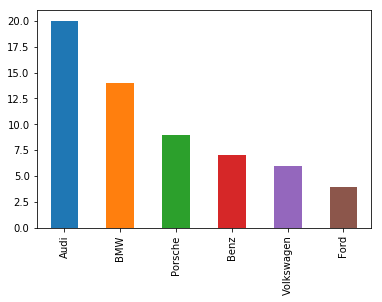Descriptive Statistics
Categorical Data
A categorical variable (also called nominal variable) use labels or names with no numerical value.
Examples
- Continent (Asia, Africa, Europe, Australia, North America, South America, Antarctica)
- Color (Red, Green, Cyan, Blue)
- Laptop Brand (Apple, Lenovo, Microsoft, Dell)
Quantitative Data
Information that can be measured in numerical values which represent measurement, frequencies etc.
Examples
- No. of Users (50, 40, 67, 178, 207)
- Battery capacity in mAh (3100, 3200, 2800, 4000, 1500)
- Milk quantity in Litres (2.5, 1.35, 6.0, 5.4)
Frequency Distribution
Let's take a dummy dataset - 60 Users' car brands
| Audi | Audi | BMW | Audi | Porsche | Audi | | Ford | Audi | Volkswagen | BMW | BMW | Audi | | Porsche | Volkswagen | BMW | Audi | BMW | BMW | Audi | Porsche | Audi | Benz | BMW | Benz | | Volkswagen | BMW | Audi | Audi | Porsche | Porsche | | Audi | BMW | Audi | Audi | Porsche | Benz | | Benz | Porsche | Audi | BMW | Volkswagen | BMW | | Volkswagen | BMW | Audi | Audi | Porsche | Benz | Benz | Ford | Audi | Volkswagen | Benz | Ford | | Ford | Audi | BMW | Audi | Porsche | BMW |
import pandas as pd
import matplotlib
cars = ['Audi', 'Audi', 'BMW', 'Audi', 'Porsche', 'Audi',
'Ford', 'Audi', 'Volkswagen', 'BMW', 'BMW', 'Audi',
'Porsche', 'Volkswagen', 'BMW', 'Audi', 'BMW', 'BMW',
'Audi', 'Porsche', 'Audi', 'Benz', 'BMW', 'Benz',
'Volkswagen', 'BMW', 'Audi', 'Audi', 'Porsche', 'Porsche',
'Audi', 'BMW', 'Audi', 'Audi', 'Porsche', 'Benz',
'Benz', 'Porsche', 'Audi', 'BMW', 'Volkswagen', 'BMW',
'Volkswagen', 'BMW', 'Audi', 'Audi', 'Porsche', 'Benz',
'Benz', 'Ford', 'Audi', 'Volkswagen', 'Benz', 'Ford',
'Ford', 'Audi', 'BMW', 'Audi', 'Porsche', 'BMW'
]
cars_df = pd.DataFrame(cars, columns = ['brand'])
frequency_distribution = cars_df.brand.value_counts()
print(frequency_distribution)
Audi 20
BMW 14
Porsche 9
Benz 7
Volkswagen 6
Ford 4
Name: brand, dtype: int64
Let's plot a Bar chart for the Frequency distribution
frequency_distribution.plot.bar()

Averaging data
Let's take an example data set of Marks of 20 students in a class out of 100.
import numpy as np
grades = [60, 75, 78, 48, 89, 94, 69, 98, 91, 71,
89, 41, 67, 94, 60, 58, 96, 83, 81, 92]
Mean
Arithmetic Mean
Arithmetic mean is calculated as sum of all numbers in the dataset and dividing by the total number of values
Arithmetic mean =
= (60 + 75 + 78 + ... + 92) / 20 = 76.7
arithmetic_mean = np.mean(grades)
print(f'Arithmetic mean = {arithmetic_mean}')
Arithmetic mean = 76.7
Geometric Mean
Geometric mean is calculated as Nth root of Product of all the numbers, where N is the total number of values in the dataset
Geometric mean =
=
from scipy.stats.mstats import gmean
geometric_mean = gmean(grades)
print(f'Geometric mean = {geometric_mean}')
Geometric mean = 74.69662039171091
Median
Median is the middle value, when the data is sorted in ascending order.
grades_sorted = sorted(grades)
print(grades_sorted)
[41, 48, 58, 60, 60, 67, 69, 71, 75, 78, 81, 83, 89, 89, 91, 92, 94, 94, 96, 98]
^^ ^^
middle numbers
Hence, Median = (78 + 81) / 2 = 79.5
Let's verify,
grades_median = np.median(grades)
print(f'Median = {grades_median}')
Median = 79.5
Mode
Mode is the number occurring most often in the dataset
In our dataset, 89, 94 and 60 occurs two times.
Hence, Mode = 89, 94, 60
Measuring Variability of Data
Interquartile range (IQR)
Interquartile range or IQR is the amount spread in middle 50% of the dataset or the distance between first Quartile (Q₁) and third Quartile (Q₃)
- First Quartile (Q₁) = Median of data points to left of the median in ordered list
- Second Quartile (Q₂) = Median of data
- Third Quartile (Q₃) = Median of data points to right of the median in ordered list
[41, 48, 58, 60, 60, 67, 69, 71, 75, 78, 81, 83, 89, 89, 91, 92, 94, 94, 96, 98]
^^^^^^^^^^^^^^^^^^^^^^^^^^^^^^^^^^^^^^ ^^^^^^^^^^^^^^^^^^^^^^^^^^^^^^^^^^^^^^
first half second half
median = (60 + 67) / 2 = 63.5 median = (91 + 92) / 2 = 91.5
Q₁ = 63.5
Q₃ = 91.5
IQR = Q₃ - Q₁ = 91.5 - 63.5 = 28
Range
Range is the difference between largest number and smallest number
grades_range = max(grades) - min(grades)
print(f'Range = {grades_range}')
Range = 57
Variance
Variance measures how far the numbers are spread out from the mean.
- Variance, σ² =
print(f'Arithmetic mean = {arithmetic_mean}') # Mean
variance = ( sum([(x - arithmetic_mean) ** 2 for x in grades]) ) / 20
print(f'Variance = {variance}')
Arithmetic mean = 76.7
Variance = 5420.200000000001
Standard Deviation
Standard deviation is the square root of Varaince
- Standard Deviation, σ =
std_deviation = np.sqrt(variance)
print(f'Standard Deviation = {std_deviation}')
Standard Deviation = 16.462381358722073
Z-Score
Z-Score is a measure of how many Standard Deviations above/below the Arithmetic mean a raw score is.
- Z-Score =
def z_score(raw_score, mean, std_deviation):
"""Calculates the statistical `z-score` value given `raw_score`, `mean`,
and `std_deviation`
Arguments:
raw_score - Raw score
mean - Mean
std_deviation - Standard deviation
"""
return (raw_score - mean) / std_deviation
z_score_60 = z_score(60, arithmetic_mean, std_deviation)
print(f'Z-score of 60 = {z_score_60}')
Z-score of 60 = -1.0144340381929031